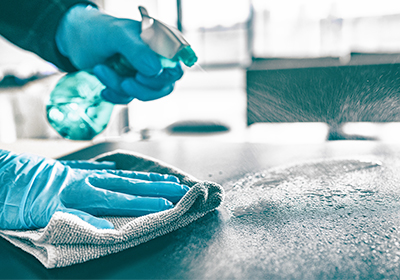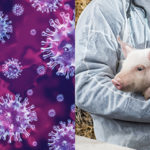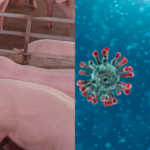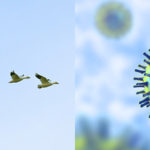SARS-CoV-2, the coronavirus responsible for COVID-19, can survive on surfaces for up to 28 days: longer than any other coronavirus. The survival and contagiousness of the virus are also influenced by environmental conditions. This was the conclusion of a systematic review of the literature, conducted by a research team from the Istituto Zooprofilattico Sperimentale delle Venezie (IZSVe), published in Science of the Total Environment.
The role of fomites in SARS-CoV-2 transmission

Fomites are inanimate objects or porous/non porous surfaces which, if contaminated or exposed to pathogens, can transmit an infectious disease to a new host. Researchers from the IZSVe conducted a systematic review of the scientific literature to determine surface survival of human coronaviruses (SARS-CoV-2, SARS-CoV-2 and MersCoV).
COVID-19 is a respiratory disease caused by SARS-CoV-2, the virus responsible for the pandemic which has spread to almost 200 countries since the end of 2019. SARS-CoV-2 takes its place alongside other human coronaviruses (hCoV), of which two had a major impact on humans since 2002 for their lethality and ability to infect humans, namely SARS-CoV (Severe Acute Respiratory Syndrome coronavirus), responsible for the SARS epidemic of 2002-2004, and MersCoV, responsible for Middle East Respiratory Syndrome.
COVID-19, like every emerging disease, requires the active participation of the scientific community to understand its pathogenesis and transmission mechanisms in order to appropriately establish diagnostic and therapeutic protocols. One of the many questions to which scientists have sought a swift answer is the route of SARS-CoV-2 transmission. While it has been amply demonstrated that the virus is primarily transmitted via direct contact with an infected person, the potential for a virus to be transmitted via contaminated surfaces (fomites) is also deemed possible, but not yet supported by robust scientific evidence.
Fomites are inanimate objects or porous/non porous surfaces which, if contaminated or exposed to pathogens, can transmit an infectious disease to a new host. Soiled clothing, towels, sheets, handkerchiefs, surgical dressings, and contaminated needles are all examples of fomites. The literature has demonstrated the ability of fomites to transmit respiratory viruses and enteric pathogens, but their role in SARS-CoV-2 is still widely unknown. Taking a precautionary approach from the start of the pandemic – given the lack of available evidence on the role of fomites – numerous guidelines recommended cleaning and disinfecting surfaces, the use of disposable gloves, and hand hygiene as preventive measures.
One of the first steps in studying the infectiousness of SARS-CoV-2 via surfaces is to determine surface survival of the virus, by collecting extensive evidence of fomites’ potential as a route of viral transmission. The analysis must also include the virus’ persistence in the environment, which in turn depends on its structural characteristics, environmental factors (temperature, relative humidity, exposure to UV radiation), and the characteristics of the fomite.
The IZSVe study

The study showed that banknotes (polymer and paper), glass, and steel were able to transmit the virus for up to a maximum of 21 days, i.e. the period during which SARS-CoV-2 viral load proved dangerous for humans. High temperatures combined with relative humidity tend to inactivate SARS-CoV and reduce SARS-CoV-2 survival, as also UV radiation and sunlight.
Researchers from the Istituto Zooprofilattico Sperimentale delle Venezie (IZSVe) conducted a systematic review of the scientific literature to determine surface survival of SARS-CoV-2. The review also included two other important human coronaviruses, namely, MersCoV and SARS-CoV, in view of their danger to public health.
Analysis of the evidence was based on 18 articles published in the scientific literature, selected after screening 1,436 papers, retrieved from multiple databases as relevant to the research question. Coronavirus survival was assessed on various materials: polymers (plastic, PVC, Teflon, disposable gloves etc.), metals (steel, aluminum, copper etc.), glass, paper, wood, fabrics (cloth, disposable and cotton gowns), face masks, sterile sponges, ceramic, banknotes, mosaics, and soil.
The systematic review revealed that SARS-CoV-2 can survive at room temperature for up to 28 days on glass, steel, plastic polymers (polymer banknotes and vinyl), paper banknotes, and for up to 7 days on the outer layer of surgical masks. Twenty-eight days is the longest survival time to have been demonstrated in the laboratory. SARS-CoV is the coronavirus with the longest reported survival after SARS-CoV-2, persisting for up to 14 days on glass fomites. Tests on human contamination through surfaces, i.e. the potential for an infection to be transmitted via fomites, showed instead that banknotes (polymer and paper), glass, and steel were able to transmit the virus for up to a maximum of 21 days, i.e. the period during which SARS-CoV-2 viral load proved dangerous for humans.
Environmental conditions also influence the virus’ ability to survive on fomites: high temperatures combined with high relative humidity tend to inactivate SARS-CoV and reduce SARS-CoV-2 survival. Conversely, low temperatures and low humidity increase their viability irrespective of the type of surface colonized by the virus. UV radiation and sunlight can also reduce the coronavirus survival on surfaces. During the summertime in particular, surfaces exposed to sunlight (particularly those built of stainless steel) are very unlikely to be able to transmit the virus, suggesting that infectiousness is highest among fomites not exposed to sunlight.
Towards a harmonised approach

The collected evidence can be used, particularly by risk managers, to improve prevention measures that increasingly reflect individual fomites’ real potential to act as sources of infection. This could, for example, help reduce the indiscriminate use of disinfectants and detergents, which have a negative impact on the environment.
The IZSVe study contributes to greater understanding of human coronaviruses, specifically SARS-CoV-2 in the human-environment-animal ecosystem. The collected evidence can be used, particularly by risk managers, to improve prevention measures that increasingly reflect individual fomites’ real potential to act as sources of infection. This could, for example, help reduce the indiscriminate use of disinfectants and detergents, which have a negative impact on the environment.
During the pandemic of the last two years, the scientific community has striven to investigate the surface survival and infectiousness of SARS-CoV-2. New experimental studies or more recent systematic reviews could provide contrasting results or update the evidence presented in the study. However, the work performed by IZSVe also highlights some limits in the currently available literature which could prompt future research on this specific topic.
First and foremost, marked methodological differences in the various trials make currently available studies hard to compare with each other. This prevented the IZSVe research team from demonstrating a link between virus survival time and contaminated surface characteristics and prompts the need to define a reference working protocol for virus survival trials.
In addition, the results yielded by the systematic review are based on laboratory trials conducted under experimental conditions, and may not therefore reflect the real resistance of SARS-CoV-2. This warrants the need to perform studies that more closely simulate the actual spread of the virus in the environment.
Read the scientific article in Science of the Total Environment »









